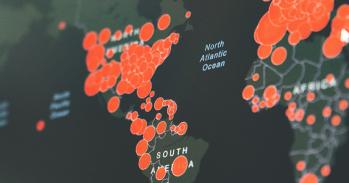
The next Ebola outbreak could be predicted using a new model that tracks how changes to ecosystems and human societies combine to affect the spread of the deadly infectious disease.
The next Ebola outbreak could be predicted using a new model that tracks how changes to ecosystems and human societies combine to affect the spread of the deadly infectious disease.
The results suggest investment in primary health care across sub-Saharan Africa could have the most beneficial impact in reducing future Ebola risk.
James Wood
The model could help policymakers to decide where to target vaccine deployment, or develop healthcare infrastructure, to reduce the risk of zoonotic disease outbreaks – illnesses that spread between animals and humans.
Analysis using the mathematical model, published in the journal Nature Communications, shows that several countries in Africa, including Nigeria, could be at risk of Ebola outbreaks both presently and in the future, despite having experienced no known cases to date.
“It is vital that we understand the complexities causing animal-borne diseases to spill-over into humans, to accurately predict outbreaks and help save lives,” said Dr David Redding at UCL Genetics, Evolution & Environment, first author of the study. “In our models, we’ve included more information about the animals that carry Ebola and, by doing so, we can better account for how changes in climate, land-use or human societies can affect human health.”
Designed by a team including researchers from UCL, University of Cambridge and Zoological Society of London (ZSL), the model captures the impact of climate, land use and human population factors on the risk of Ebola and predicts the known set of previous outbreaks with a high degree of accuracy, even in the absence of case data. The results show that Ebola outbreaks, resulting from spill-over events, are 1.6 times more likely in scenarios with increased warming and slower socioeconomic development.
Professor James Wood from Cambridge’s Department of Veterinary Medicine, who co-authored the study, said: “This work takes an unusually long-term approach to considering epidemic risk of Ebola, and identifies risks likely increasing across West as well as Central Africa. While there is always inherent uncertainty in specific predictions, the results suggest investment in primary health care across sub-Saharan Africa could have the most beneficial impact in reducing future risk.”
More than two thirds of all infectious diseases originate in animals, including Ebola, Lassa fever and West Nile virus. These diseases contribute to the global health and economic burden that disproportionately affects poor communities.
The latest Ebola epidemic has claimed more than 2,100 lives since August 2018 and while there are signs it is in retreat, the risk of spread is still high according to a recent report by the UN.
The World Bank estimates that the 2014 Ebola outbreak cost the three countries most affected many billions of dollars, due to infrastructure breakdown, mass migration, crop abandonment and a rise in endemic disease due to overrun healthcare systems, among other drivers.
The team used a first principles approach of how humans interact with wildlife and how Ebola spreads within human populations to develop the predictive framework, which could also be adapted for other zoonotic diseases.
“Importantly, our model is flexible enough to allow us to predict Ebola outbreaks in alternative, simulated versions of the world. For example, we examine a set of plausible future environments and show stark differences in how Ebola responds to the best-case and worst-case scenarios of future climate change and poverty alleviation,” explained co-author Professor Kate Jones at UCL Genetics, Evolution & Environment and Institute of Zoology, ZSL.
The study was funded by the Natural Environmental Research Council, Economic and Social Research Council, the Medical Research Council, the Royal Society and the Wellcome Trust.
Reference:
Redding, DW et al. 'Understanding the impact of environmental and socio-economic factors on emergence and epidemic potential of Ebola in Africa’, Nature Communications (2019), DOI: 10.1038/s41467-019-12499-6.
Adapted from a press release by UCL.

The text in this work is licensed under a Creative Commons Attribution 4.0 International License. Images, including our videos, are Copyright ©University of Cambridge and licensors/contributors as identified. All rights reserved. We make our image and video content available in a number of ways – as here, on our main website under its Terms and conditions, and on a range of channels including social media that permit your use and sharing of our content under their respective Terms.




